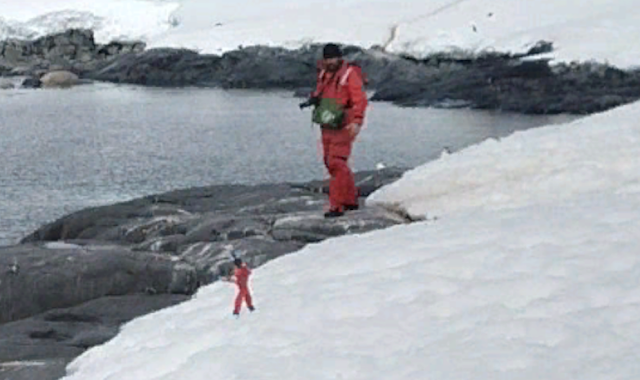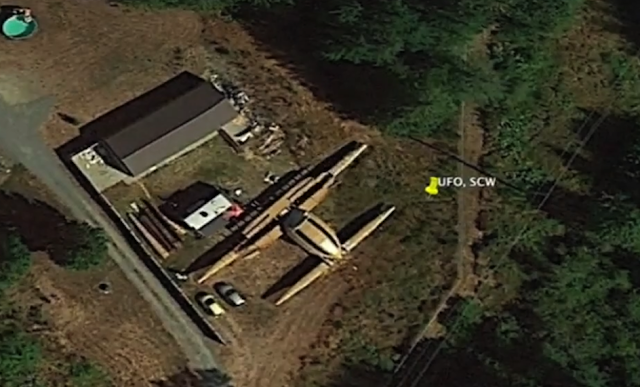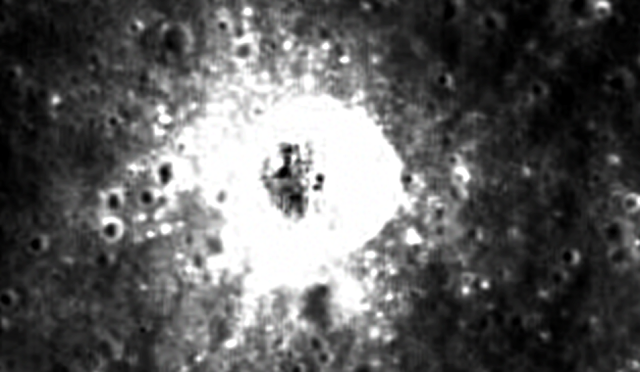Location of discovery: Spain


UK Daily Mail article: https://www.dailymail.co.uk/news/article-12838131/Secrets-Area-51-Metallic-egg-shaped-UFO-1980s-whistleblower-claims.html#comments
The UK news site Daily Mail had an interesting story today, one about an egg shaped UFO at Area 51 in the 1980-90s. I will put the link above this so you can see it. It's not just rumor. Its true. Oh, and when it's powered up, it glows blue.

In December 2023, a startling discovery was made using Google Earth that has captured the imagination and curiosity of people worldwide. UFO researcher Scott C. Waring reported finding an image of what appears to be a tiny human, approximately seven inches tall, dressed in an orange jumpsuit, in Antarctica. This finding, located at the coordinates 64°49'18.09"S 63°6'18.34"W, has sparked significant interest and speculation. This article explores the details of the discovery, the historical context of legends involving little people, and the broader implications of such a find.
Initial Observation: Using Google Earth, Waring identified an image that appears to show a tiny human figure in Antarctica. The figure is dressed in an orange jumpsuit, resembling the attire of scientific expedition members. However, the scale of the figure is what makes it extraordinary, as it appears to be only about seven inches tall.
Location and Context: The coordinates point to a specific location in Antarctica, a continent known for its harsh conditions and relatively unexplored terrain. The image also includes what seems to be a boat with a round black insignia, which Waring speculates could belong to a team conducting research or a military operation.
Eyewitness Description: Waring describes the tiny human as perplexing and unusual. He notes that while the figure resembles a human team member, the size discrepancy raises questions about its true nature and origin. The image has been scrutinized, and while some suggest it could be a trick of light or a photographic anomaly, others are intrigued by the possibility of a new discovery.
Global Folklore: Stories of little people have been a part of global folklore for thousands of years. From the leprechauns of Ireland to the pukwudgies of Native American lore, many cultures have legends about small humanoid beings. These stories often depict little people as elusive, magical, or possessing unique abilities.
Scientific Investigations: In recent years, there have been scientific investigations into the possibility of small human-like beings. The discovery of the "Hobbit" skeletons on the Indonesian island of Flores in 2003, known as Homo floresiensis, provided evidence that small-statured human species did exist in the past.
Modern Sightings and Theories: Modern sightings of tiny humans are rare and often controversial. However, the fascination with the possibility of such beings persists. Some researchers speculate that if such beings exist, they could have remained hidden in remote areas or developed ways to avoid detection by humans.
Image Verification: The first step in analyzing the discovery is to verify the authenticity of the Google Earth image. This involves checking for any possible distortions, reflections, or other anomalies that could explain the tiny figure without resorting to extraordinary explanations.
Scale and Proportion: The scale of the figure relative to its surroundings needs careful examination. If the figure is indeed only seven inches tall, it raises questions about its biological feasibility and how such a being could survive in the harsh Antarctic environment.
Clothing and Equipment: The orange jumpsuit worn by the figure is similar to those used by scientific research teams in Antarctica. This could suggest that the figure is either part of a team or mimicking human attire. The presence of the boat with a black insignia also needs to be explored to understand the context of the scene.
Photographic Anomaly: One theory is that the tiny human is a result of a photographic anomaly or a trick of perspective. Google Earth images are stitched together from multiple satellite photos, and sometimes these can create unusual visual effects.
Miniature Humans: Another possibility is that there are indeed tiny human-like beings living in Antarctica. This would be a groundbreaking discovery, suggesting a parallel evolution or an unknown branch of the human family tree.
Extraterrestrial Origin: Waring speculates that alien beings could vary greatly in size, from microscopic to enormous. If the tiny human is of extraterrestrial origin, it might represent a species that has either evolved or engineered itself to be small.
Mythological Connections: The discovery could also reignite interest in ancient myths and legends about little people. If these beings exist, they might have been the inspiration for many folklore stories around the world.
Scientific Exploration: Confirming the existence of tiny humans would revolutionize several scientific fields, including anthropology, biology, and evolutionary science. Researchers would need to understand how these beings live, reproduce, and adapt to their environment.
Technological Advancements: If the tiny humans possess advanced technology or unique biological traits, studying them could lead to technological innovations. This might include new insights into miniaturization, survival mechanisms, or even space travel.
Cultural and Ethical Considerations: The discovery of a new intelligent species would have profound cultural and ethical implications. Humanity would need to consider the rights and treatment of these beings, ensuring they are respected and protected.
Interdisciplinary Collaboration: Exploring this phenomenon would require collaboration across various disciplines, from geology and climatology to genetics and sociology. Such interdisciplinary efforts could lead to new ways of thinking and problem-solving.
Homo Floresiensis: The discovery of Homo floresiensis in Indonesia provided concrete evidence that small-statured human species once existed. These "hobbits" were about three feet tall and lived around 50,000 years ago. This discovery opened the door to the possibility that other small human-like species might exist.
Mythical Creatures: Throughout history, cultures worldwide have myths about little people. The Irish leprechauns, Scandinavian trolls, and Native American pukwudgies are just a few examples. These myths often depict little people as elusive, magical beings living in remote or hidden places.
Modern Cryptozoology: Cryptozoology, the study of creatures whose existence is not yet proven by science, includes research into little people. While mainstream science often dismisses these claims, cryptozoologists continue to explore and document sightings and evidence.
Harsh Conditions: Antarctica is one of the most extreme environments on Earth, with freezing temperatures, high winds, and vast ice sheets. The discovery of tiny humans in such a hostile environment would suggest incredible adaptability and resilience.
Unexplored Territories: Despite advancements in technology, much of Antarctica remains unexplored. The continent's isolation and extreme conditions make it difficult to study, leaving many of its mysteries unsolved.
Subterranean and Subglacial Environments: Recent discoveries of subglacial lakes and hidden ecosystems beneath the ice suggest that Antarctica might harbor unknown forms of life. These environments could potentially provide habitats for tiny humans or other undiscovered species.
Expeditions and Field Studies: To investigate the tiny human sighting, dedicated expeditions to the specific location in Antarctica would be necessary. Researchers would need to employ advanced technologies, such as drones, submersibles, and remote sensing equipment.
Collaboration with Google: Working with Google to analyze and verify the original satellite images could provide more context and clarity. Advanced imaging techniques might reveal additional details about the tiny human and its surroundings.
Interdisciplinary Research Teams: Forming interdisciplinary research teams that include anthropologists, biologists, geologists, and climatologists would ensure a comprehensive approach to studying the phenomenon. Each discipline could contribute unique insights and methodologies.
Public Engagement and Crowdsourcing: Engaging the public through citizen science initiatives and crowdsourcing could generate additional data and interest. Platforms for sharing observations and collaborating on analysis could democratize the research process.
The discovery of what appears to be a tiny human in Antarctica, as revealed through Google Earth in December 2023, opens up a realm of fascinating possibilities and implications. Whether the image represents a photographic anomaly, a new species of miniature humans, or even an extraterrestrial being, it challenges our understanding of life and evolution.
Historical legends and modern scientific discoveries both suggest that the existence of little people is not entirely beyond the realm of possibility. The Antarctic environment, with its harsh conditions and unexplored territories, remains one of the last frontiers for discovery on our planet.
Investigating this phenomenon further would require advanced technology, interdisciplinary collaboration, and a commitment to scientific rigor. The potential findings could revolutionize our knowledge and understanding of biology, anthropology, and even technology.
As humanity continues to explore the mysteries of our world, discoveries like the tiny human in Antarctica remind us of the vast unknown that still awaits us. They inspire curiosity, drive scientific inquiry, and challenge us to expand the boundaries of our knowledge and imagination. Whether myth or reality, the story of little people endures, captivating our collective imagination and pushing the frontiers of discovery.

On December 1, 2023, a significant discovery was made using the Arecibo Radio Telescope. An object previously labeled as an asteroid, identified by the asteroid ID 2003UX34, was found to be an 800-meter-wide metal alien disk. This revelation came from detailed analysis of doppler radar data, which also showed two smaller rectangular UFOs orbiting the larger disk. The implications of this discovery are profound, raising questions about extraterrestrial life, advanced technology, and our understanding of the cosmos. Here’s an in-depth look at this astonishing find, its analysis, and the broader context of UFO research.
While sifting through Arecibo telescope data, a particular object caught my attention. Initially classified as an asteroid, 2003UX34 did not exhibit the typical characteristics of a natural celestial body. Instead, it appeared as a large, metallic disk. Measuring 800 meters in diameter, this object defied the expectations of what one would expect from a simple space rock.
The data came from the Arecibo telescope’s doppler radar images, a series of 16 frames compiled into a gif. While most images were blurry or indistinct, the final frame revealed a clear and focused shot of the UFO. This image provided compelling evidence that what was being observed was not a natural formation but a crafted, structured object.
Doppler Radar Imaging: Doppler radar imaging involves bouncing radar waves off an object and analyzing the returned signals to create a detailed picture. This technique is particularly useful for studying asteroids and other celestial bodies. The clarity and precision of the radar images from Arecibo allowed for a detailed examination of 2003UX34.
Metallic Disk: The final image in the gif revealed an 800-meter-wide metallic disk. Its shape was symmetrical and smooth, with distinct edges that contrasted sharply with the irregular shapes typical of natural asteroids. This suggested artificial construction, indicating advanced engineering capabilities.
Accompanying UFOs: In addition to the primary disk, two smaller rectangular objects were observed orbiting the larger disk. These smaller UFOs appeared to be engaged in protective and docking activities, suggesting a coordinated operation. Their presence reinforced the idea that the larger disk was a sophisticated, possibly inhabited craft.
Potential Cover-Up: The quality of the final image, compared to the previous 15 frames, raises questions about potential data manipulation. It’s plausible that clearer images were deliberately removed, leaving only one unmistakable shot. This act of omission might indicate an attempt to obscure the full extent of the discovery, highlighting the challenges UFO researchers face in uncovering the truth.
The identification of a large, metallic alien disk in our solar system has far-reaching implications:
Extraterrestrial Technology: The sheer size and complexity of the disk suggest a level of technological advancement far beyond current human capabilities. Understanding its construction and functionality could revolutionize our technological landscape, providing insights into advanced propulsion systems, materials science, and engineering.
Proof of Extraterrestrial Life: This discovery provides compelling evidence of intelligent extraterrestrial life. The presence of the disk and its accompanying UFOs suggests a civilization capable of space travel and sophisticated engineering. This challenges our understanding of life in the universe and necessitates a reevaluation of our place in it.
Potential for Contact: The proximity of such an advanced craft within our solar system raises the possibility of contact with its occupants. Whether these beings are observing us, exploring the solar system, or have other intentions, their presence opens the door to unprecedented opportunities for interaction and exchange of knowledge.
Geopolitical and Strategic Considerations: The discovery of an extraterrestrial craft has significant geopolitical implications. Nations may seek to control or access the technology for strategic advantages. It is crucial to foster international cooperation and transparency to manage the situation responsibly.
Scientific Research: This finding will undoubtedly spur further scientific research. Astronomers, physicists, and engineers will be eager to study the object in greater detail, using various observational and analytical techniques to glean as much information as possible.
The discovery of the 800-meter disk adds to a growing body of evidence supporting the existence of UFOs and extraterrestrial life. Here are some notable cases that align with this recent finding:
The Roswell Incident (1947): The Roswell Incident involved the recovery of debris from a purported alien spacecraft in New Mexico. While officially dismissed as a weather balloon, many believe it was a cover-up of an extraterrestrial encounter. The incident remains one of the most iconic UFO cases in history.
The Phoenix Lights (1997): Thousands of witnesses in Arizona reported seeing a massive V-shaped formation of lights moving silently across the sky. Despite various explanations, the event remains one of the most well-documented UFO sightings.
The Nimitz Encounter (2004): Navy pilots from the USS Nimitz encountered a Tic Tac-shaped object off the coast of California. The object demonstrated incredible speed and maneuverability, far beyond any known aircraft. The incident was captured on video and remains unexplained.
The O’Hare International Airport Sighting (2006): Pilots and ground crew at O’Hare Airport in Chicago reported seeing a disc-shaped object hovering over the airport. The object then shot upwards at incredible speed, leaving a hole in the cloud cover. Despite the FAA’s dismissal, witnesses stood by their accounts.
The East Coast Gimbal Incident (2015): Navy pilots recorded an object rotating in mid-air while maintaining a stable altitude and speed. The object’s behavior and appearance remain unexplained, and the incident was part of the Pentagon’s investigation into UAPs (Unidentified Aerial Phenomena).
These cases, among many others, suggest that encounters with unexplained aerial phenomena are not isolated incidents. The discovery of the alien disk using the Arecibo telescope further supports the hypothesis that advanced extraterrestrial civilizations are present within our solar system.
The use of AI and advanced imaging techniques in analyzing celestial objects is revolutionizing UFO research:
Image Enhancement: AI algorithms can enhance image clarity, highlight anomalies, and identify patterns that are not immediately apparent to the human eye. This capability is crucial for analyzing high-resolution images of celestial objects and identifying artificial constructs.
Pattern Recognition: AI excels at recognizing patterns and differentiating between natural and artificial objects. By analyzing shape, movement, and reflective properties, AI can help determine whether an object is a natural satellite, space debris, or an intelligently controlled craft.
Data Analysis: The vast amount of data generated by space missions and telescopes can be overwhelming. AI can efficiently sift through this data, identifying potential UFO sightings and providing researchers with actionable insights.
Predictive Modeling: AI can use historical data to predict future sightings and movements of UFOs. This capability allows researchers to focus their efforts on areas with a higher likelihood of extraterrestrial activity.
Collaboration and Sharing: AI tools facilitate collaboration and sharing of information among researchers worldwide. By standardizing analysis methods and making data accessible, AI fosters a more unified and coordinated approach to UFO research.
The discovery of the 800-meter alien disk opens new avenues for research and exploration:
Further Observations: Continued monitoring and analysis of the disk using various telescopes and observational techniques will provide more data. This includes high-resolution imaging, spectroscopy, and radio observations to understand its composition and behavior.
Mission Planning: Planning missions to study the disk up close, potentially involving robotic probes or crewed missions, will provide invaluable insights. These missions could investigate the disk’s structure, technology, and potential occupants.
International Cooperation: Given the significance of this discovery, international cooperation is essential. Collaborative efforts between space agencies, research institutions, and governments will ensure a comprehensive and responsible approach to studying the disk.
Public Engagement: Engaging the public in UFO research can help raise awareness and generate interest in space exploration. Public involvement can also lead to the discovery of new data and sightings, as more eyes are focused on the skies.
The discovery of an 800-meter alien disk using the Arecibo Radio Telescope is a groundbreaking development in UFO research. The presence of this advanced craft, accompanied by smaller UFOs, suggests that extraterrestrial civilizations are actively monitoring and possibly protecting our solar system. The use of AI and advanced imaging techniques has been instrumental in uncovering this find, demonstrating the power of modern technology in exploring the unknown.
As we continue to analyze and understand this discovery, it is crucial to approach it with scientific rigor, transparency, and international cooperation. The implications for technology, science, and our understanding of the universe are profound. The discovery challenges our perceptions and invites us to explore new frontiers, both in space and in our quest for knowledge about intelligent extraterrestrial life. The journey to uncover the secrets of the alien disk has just begun, and with continued research and exploration, we are poised to make even more remarkable discoveries.


Now this is interesting. This guy, David Grusch has come forward at the UAP hearings and is testifying that he has firsthand knowledge about and with alien technology. Now remember I do have a masters degree in counseling, and there are some interning things I noticed about Grusch. First, he 100% believes he is telling the truth. He is confident that the truth needs to be heard by the public and his eyes show that he has held this back for a long time, but it's now time for him to reveal this information. He is calm and confident. But most of all, I notice his speaking, his higher vocabulary than most people, his speed of speaking and his content (message) he is telling. It reveals to me he is highly intelligent, worthy of a high position in a secret government program, as well as to the point, which means he is use to being focused, gov worker type of focus.
Over all I find his honest and telling us his true experience. I find this highly surprising, I didn't realize he was this legit of an eyewitness. I am impressed and he will help break the secrets held by the US and world government that hold back a floodgate of UFO and alien knowledge. But, this is yet a single straw placed on a mountain of facts waiting to break the camels back.
Scott C. Waring



